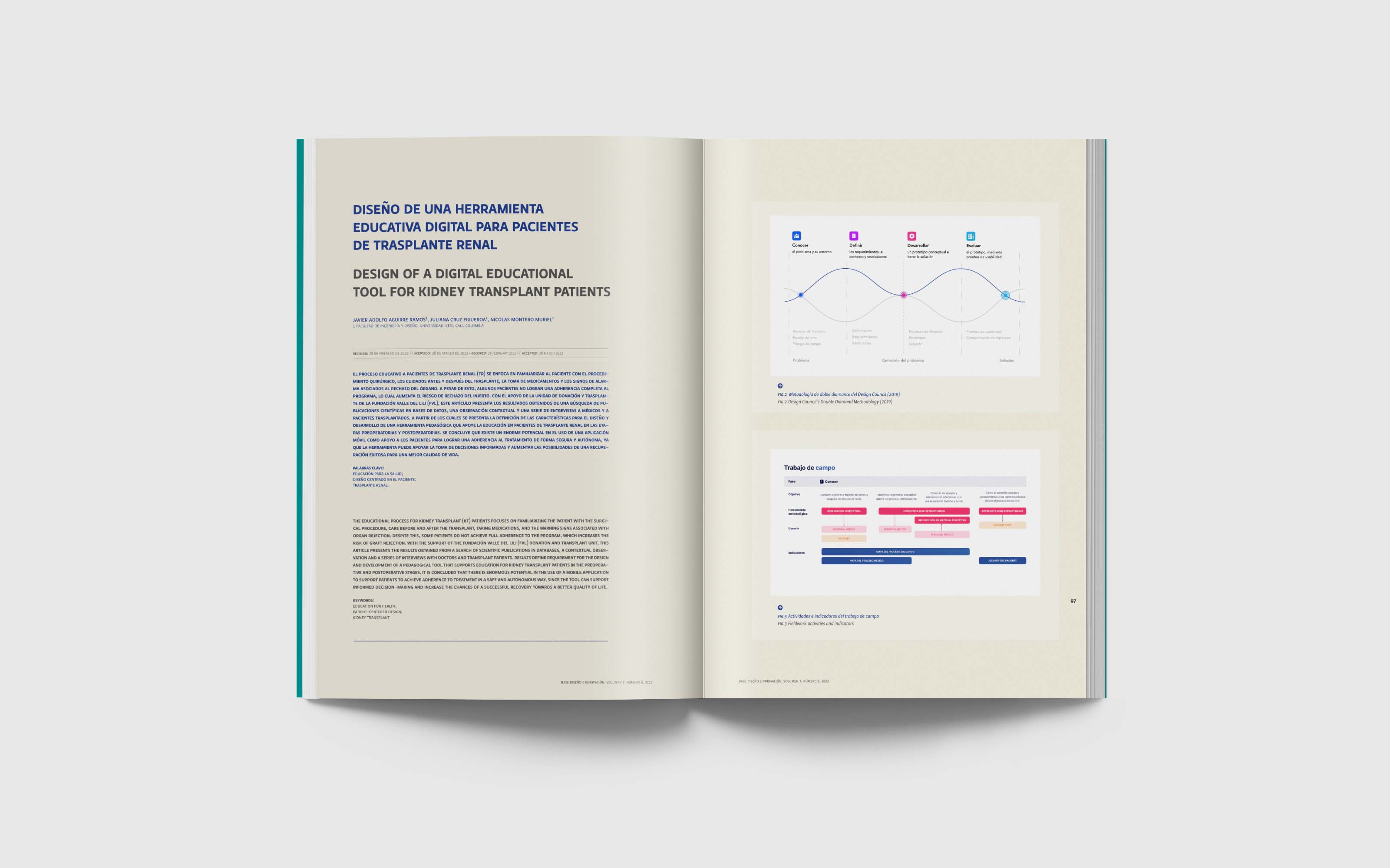Design of a digital educational tool for kidney transplant patients
Main Article Content
Abstract
The educational process for kidney transplant (KT) patients focuses on familiarizing the patient with the surgical procedure, care before and after the transplant, taking medications, and the warning signs associated with organ rejection. Despite this, some patients do not achieve full adherence to the program, which increases the risk of graft rejection. With the support of the Fundación Valle del Lili (FVL) Donation and Transplant Unit, this article presents the results obtained from a search of scientific publications in databases, a contextual observation and a series of interviews with doctors and transplant patients. Results define requirement for the design and development of a pedagogical tool that supports education for kidney transplant patients in the preoperative and postoperative stages. It is concluded that there is enormous potential in the use of a mobile application to support patients to achieve adherence to treatment in a safe and autonomous way, since the tool can support informed decision-making and increase the chances of a successful recovery towards a better quality of life.
Article Details
References
Fredericks, E. M., & Dore-Stites, D. (2010). Adherence to immunosuppressants: how can it be improved in adolescent organ transplant recipients? Current Opinion in Organ Transplantation, 15(5), 614–620. https://doi.org/10.1097/mot.0b013e32833d3115
Gamarra, G., & Gómez, J. (1991). Rechazo en pacientes con trasplante renal. Acta Médica Colombiana, 16(5), 244–255. http://www.actamedicacolombiana.com/anexo/articulos/05-1991-03-.pdf
Guerra Guerrero, V. T., Díaz Mujica, A. E., & Vidal Albornoz, K. (2010). La educación como estrategia para mejorar la adherencia de los pacientes en terapia dialítica. Revista Cubana de Enfermería, 26(2), 52–62. http://scielo.sld.cu/scielo.php?script=sci_arttext&pid=S0864-03192010000200007&lng=es&tlng=es.
Guldager, T. B., Hyldgaard, C., Hilberg, O., & Bendstrup, E. (2021). An E-Learning Program Improves Patients’ Knowledge After Lung Transplantation. Telemedicine and e-Health, 27(7), 800–806. https://doi.org/10.1089/tmj.2020.0101
Hamid, M., Rogers, E., Chawla, G., Gill, J., Macanovic, S., & Mucsi, I. (2022). Pretransplant Patient Education in Solid-organ Transplant: A Narrative Review. Transplantation, 106(4) 722–733. https://doi.org/10.1097/tp.0000000000003893
Instituto Nacional de Salud (2019). Informe Ejecutivo 2019. Coordinación de la Red Nacional de Donación y Trasplantes. https://www.ins.gov.co/Direcciones/RedesSaludPublica/DonacionOrganosYTejidos/Estadisticas/informe-ejecutivo-red-donacion-y-trasplantes-2019.pdf
Najafizada, M., Rahman, A., & Oxford, K. (2021). Analyzing models of patient-centered care in Canada through a scoping review and environmental scan. Journal of Public Health (2021). https://doi.org/10.1007/s10389-021-01528-8
Mohammed, K., Nolan, M. B., Rajjo, T., Shah, N. D., Prokop, L. J., Varkey, P., & Murad, M. H. (2014). Creating a Patient-Centered Health Care Delivery System. American Journal of Medical Quality, 31(1), 12–21. https://doi.org/10.1177/1062860614545124
Ortiz, M. R. (2021). Best Practices in Patient-Centered Care: Nursing Theory Reflections. Nursing Science Quarterly, 34(3), 322–327. https://doi.org/10.1177/08943184211010432
Pueyo-Garrigues, M., San Martín Loyola, Á., Caparrós Leal, M. C., & Jiménez Muñoz, C. (2016, 1 enero). Educación para la salud en el paciente trasplantado y su familia en una unidad de cuidados intensivos. Enfermería Intensiva, 27(1), 31–39. https://doi.org/10.1016/j.enfi.2015.11.002
Rodrigue, J. R., Nelson, D. R., Hanto, D. W., Reed, A. I., & Curry, M. P. (2013). Patient-Reported Immunosuppression Nonadherence 6 to 24 Months after Liver Transplant: Association with Pretransplant Psychosocial Factors and Perceptions of Health Status Change. Progress in Transplantation, 23(4), 319–328. https://doi.org/10.7182/pit2013501
Reis, C. I., Freire, C. S., Fernández, J., & Monguet, J. M. (2011). Patient Centered Design: Challenges and Lessons Learned from Working with Health Professionals and Schizophrenic Patients in e-Therapy Contexts. In M. M. Cruz-Cunha, J. Varajão, P. Powell, R. Martinho (Eds.) ENTERprise Information Systems. CENTERIS 2011. Communications in Computer and Information Science, vol 221 (1–10). Springer, Berlin, Heidelberg. https://doi.org/10.1007/978-3-642-24352-3_1
Tostado, A. (2020). Educación para el autocuidado y la mejora de la calidad de vida en pacientes receptores de trasplante de pulmón [Undergraduate thesis, Universidad Pontificia Comillas, Escuela Universitaria de Enfermería y Fisioterapia]. Repositorio Universidad Pontificia Comillas. https://repositorio.comillas.edu/xmlui/handle/11531/58434
Weiss, M., Johnson, N. L., Malin, S., Jerofke, T., Lang, C., & Sherburne, E. (2008). Readiness for Discharge in Parents of Hospitalized Children. Journal of Pediatric Nursing, 23(4), 282–295. https://doi.org/10.1016/j.pedn.2007.10.005
Zanetti-Yabur, A., Rizzo, A., Hayde, N., Watkins, A. C., Rocca, J. P., & Graham, J. A. (2017). Exploring the usage of a mobile phone application in transplanted patients to encourage medication compliance and education. The American Journal of Surgery, 214(4), 743–747. https://doi.org/10.1016/j.amjsurg.2017.01.026


